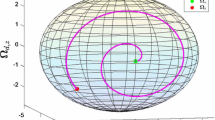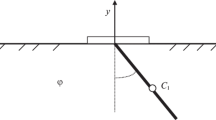Abstract
A planar system of rigid bodies interconnected by one degree of freedom rotational joints is considered. This multibody system is referred to as a multilink, and the rigid bodies are referred to as links. The angular momentum of the multilink is conserved but is not necessarily zero. We show that if the number of links is at least four, then periodic joint motions can make the absolute orientation of a specified base link track exactly a specified function of time whose time derivative is periodic. This result on the use of periodic joint motions for orientation tracking extends previous work [15], [20], [22] on using periodic joint motions for rest-to-rest reorientation. It has interesting physical consequences. Specifically, in the case of non-zero angular momentum periodic joint motions can maintain the orientation of the base link constant. In the case of zero angular momentum periodic joint motions can change the orientation of the base link at a specified angular rate. We also demonstrate that if the multilink consists of at least three links, then for any value of the angular momentum joint motions can reorient the multilink arbitrarily over anarbitrary time interval. This result extends similar results in [15] for zero angular momentum and in [20] that apply for nonzero angular momentum but not for an arbitrary time interval. In terms of their control-theoretic aspects, the problems treated in the paper can be viewed as controllability problems for a class of nonlinear control system with time-dependent drift.
Similar content being viewed by others
References
S. Dubowsky and E. Papadopoulos, The kinematics, dynamics and control of free-flying and free-floating space robotic systems.IEEE Trans. Robot. Automat. 9 (1993), No. 5, 531–543.
C. Fernandes, L. Gurvits, and Z. Li, Near-optimal nonholonomic motion planning for a system of coupled rigid bodies.IEEE Trans. Automat. Control 39 (1994), No. 3, 450–464.
C. Fernandes, Attitude control of space platform/manipulator system using internal motion.Space Robot. Dynam. and Control. Y. Xu and T. Kanade, eds.,Kluwer, 1993, 131–159.
C. Frohlich, Do springboard divers violate angular momentum conservation?Am. J. Phys. 47 (1979), 583–592.
E. Gilbert and D. Johnson, Distance functions and their application to robot path planning in the presence of obstacles.IEEE J. Robot. Automat. RA-1 (1985), No. 1.
L. Gurvits and Z. X. Li, Smooth time-periodic feedback solutions for nonholonomic motion planning. In: Nonholonomic Motion Planning. Z. Li and J. F. Canny, eds.,Kluwer, 1993, 53–108.
T. R. Kane and M. P. Scher, A dynamical explanation of the falling cat phenomenon.Int. J. Solid Struct. 5 (1969), 663–670.
—, Human self-rotation by means of limb movements.J. Biomech. 3 (1970), 39–49.
M. Kawski, High order local controllability. In: Nonlinear Controllability and Optimal Control. H.J. Sussmann, ed.,Pure Appl. Math. 133, 431–467.
I. Kolmanovsky, N. H. McClamroch, and V. T. Coppola, Exact tracking for a planar multilink in space using internal actuation.Proc. Am. Control Conf. 1 (1994), 143–147.
P. S. Krishnaprasad, Geometric phases and optimal reconfiguration for multibody systems.Proc. Am. Control Conf. 3 (1990), 2440–2444.
N. E. Leonard and P. S. Krishnaprasad, Averaging for attitude control and motion planning.Proc. 32nd Conf. Decision and Control 4 (1993), 3098–3104.
W. Liu, Averaging theorems for highly oscillatory differential equations and iterated Lie brackets.Rept. SYCON-93-14,Rutgers Center for Syst. and Control (1993).
P. Lochak and C. Meunier, Multiphase averaging for classical systems.Springer, 1988.
M. Reyhanoglu and N. H. McClamroch, Planar reorientation maneuvers of space multibody systems using internal controls.J. Guidance, Control Dynam. 15 (1992), No. 6, 1475–1480.
R. Montgomery, The isoholonomic problem and some applications.Commun. Math. Phys. 128 (1990), 565–592.
M. Reyhanoglu and N. H. McClamroch, Nonlinear attitude control of planar structures in space using only internal controls.Fields Inst. Commun. 2 (1993), 91–100.
A. Shapere and F. Wilczek, Gauge kinematics of deformable bodies.Geometr. Phases in Phys., World Scientific, Singapore, 1989, 449–460.
N. Sreenath, Y. G. Oh, P. S. Krishnaprasad, and J. E. Marsden, The dynamics of coupled planar rigid bodies.Dynam. Stability Syst. 3 (1988), 25–49.
N. Sreenath, Nonlinear control of planar multibody systems in shape space.Math. Control Signals Syst. 5 (1992), No. 4, 343–363.
H. J. Sussmann, A general theorem on local controllability.SIAM J. Control Optimiz. 25 (1987), 1588–1594.
G. C. Walsh and S. S. Sastry, On reorienting linked rigid bodies using internal motions.Proc. IEEE Trans. Robot. Automat. 11 (1995), No. 1.
Author information
Authors and Affiliations
Additional information
Supported by the National Science Foundation Grants No. MSS-9114630 and No. MSS-9309165.
Rights and permissions
About this article
Cite this article
Kolmanovsky, I., McClamroch, N.H. & Coppola, V.T. New results on control of multibody systems which conserve angular momentum. Journal of Dynamical and Control Systems 1, 447–462 (1995). https://doi.org/10.1007/BF02255892
Received:
Issue Date:
DOI: https://doi.org/10.1007/BF02255892




